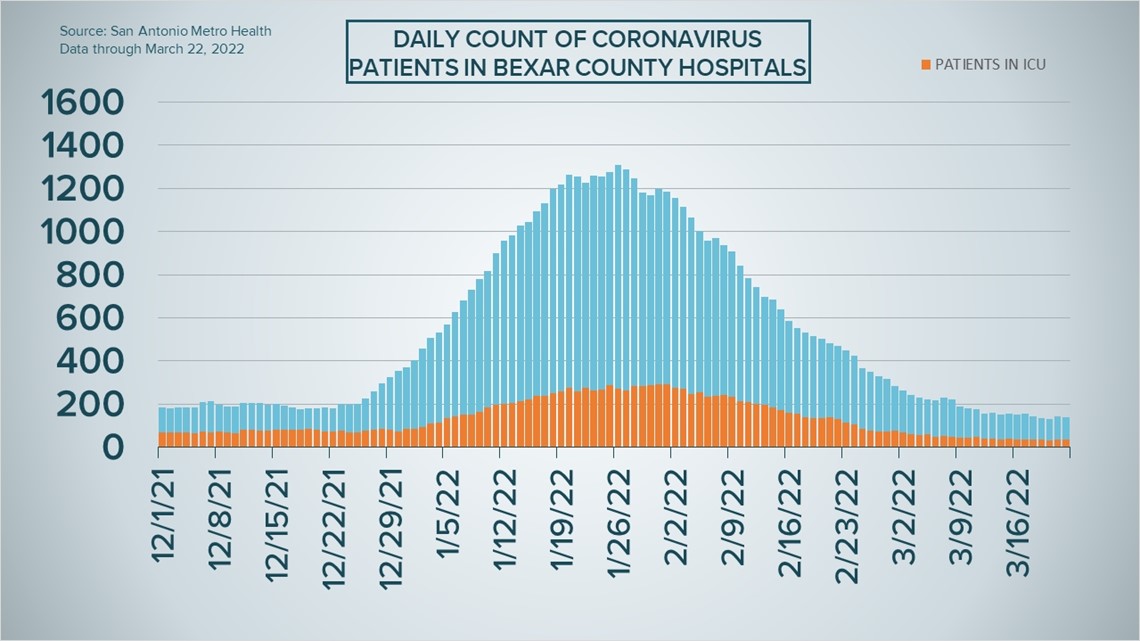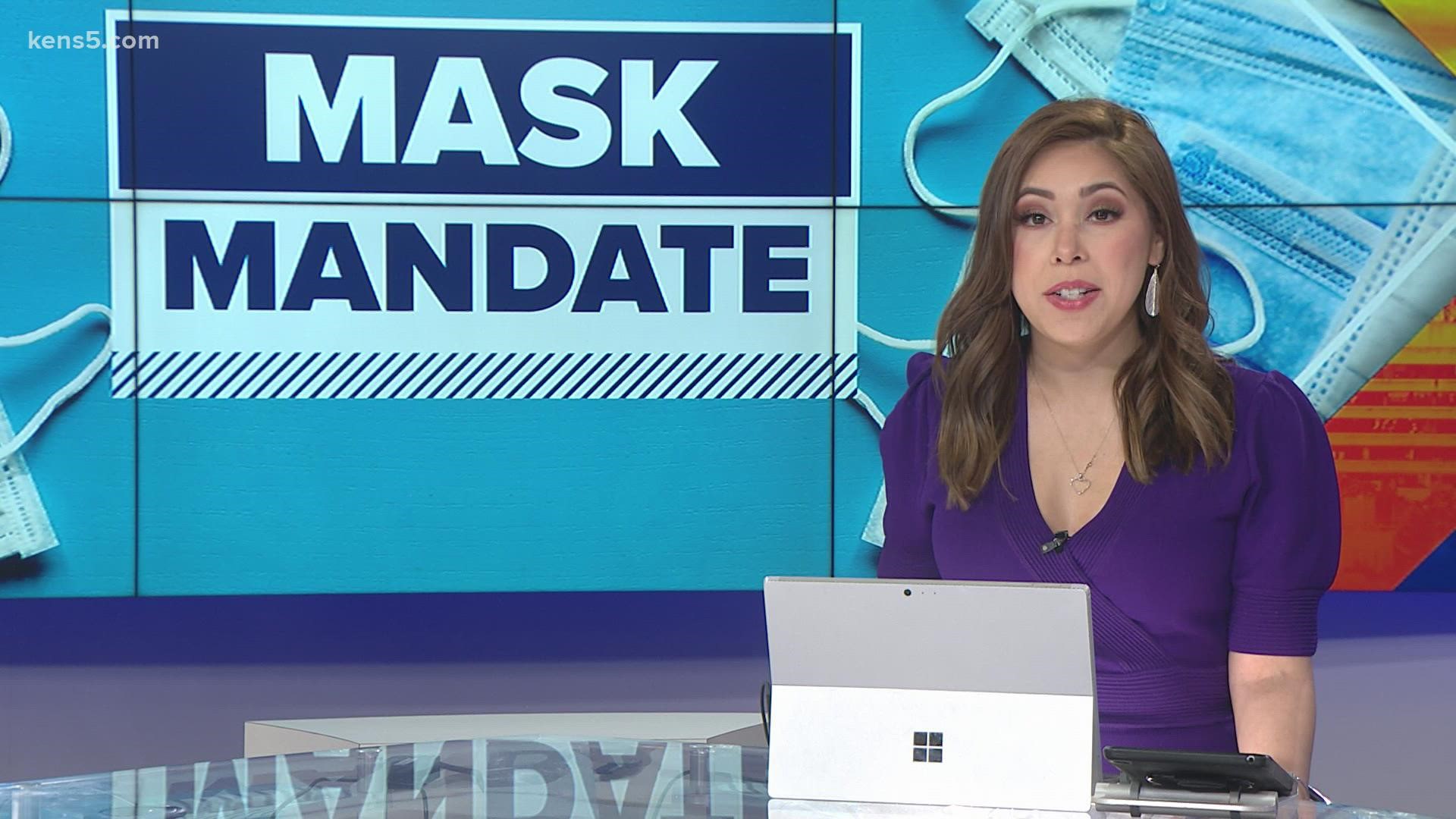SAN ANTONIO — Despite increasingly lower COVID-19 case counts and hospitalizations, Metro Health's coronavirus risk level increase from the safest threshold to "mild" for a few days before dropping back down to "low" Tuesday afternoon.
Junda Woo, Metro Health medical director, said the community can expect more of that fluctuation for the time being. The reason: recent pandemic developments in the U.K., where COVID-19 trends have proven a reliable indicator for what's to come in the U.S.
Specifically, local health authorities pointed to a more contagious form of the omicron variant that makes up 6% of Bexar County as of Monday. That COVID-19 variant has resulted in a new surge in hospitalizations in the U.K.
"We're particularly concerned about Europe, because every time that Europe has had an increase we have followed them weeks to a month or so afterwards," an infectious disease specialist with University Health told KENS 5 last week.
Metro Health says the community can still take proactive steps to mitigate the next potential surge, including being up to date on vaccines.
"It's now important than ever to get your booster vaccine, especially for those over 65," the health agency said in an emailed statement, adding that just 35% of Bexar County's vaccine-eligible population has received a booster.
Those older than 50, pregnant women and community members with "multiple chronic health conditions" can especially benefit from getting their booster, officials said.
Just 21 new coronavirus cases were tallied by Metro Health in Bexar County for Tuesday, alone with one additional virus-related death. The seven-day case average has dropped to 57, a new 2022 low and the lowest that number has been since June 2020.
Local COVID-19 hospitalizations, meanwhile, dropped slightly to 138. The number of patients has fallen by 71% over the last month.
Of those 138 patients, 34 are in intensive care and 18 are using ventilators to help them breathe.
How Bexar County is trending




Vaccine Progress in Bexar County
The following numbers are provided by San Antonio Metro Health. A full breakdown can be found here.
- 1.432 million eligible Bexar County residents are fully vaccinated as of Monday, March 14
- More than 490,000 eligible Bexar County residents have received their COVID-19 booster shot, as of Monday, March 14.
The CDC states that "when a high percentage of the community is immune to a disease (through vaccination and/or prior illness)," that community will have reached herd immunity, "making the spread of this disease from person to person unlikely."
The City of San Antonio breaks down the vaccination rates by zip code on Metro Health's Vaccination Statistics page.
Coronavirus in Texas
The total number of coronavirus cases in the state since the pandemic began grew by 5,253 on Tuesday, according to the Texas Department of State Health Services. That total includes 4,108 new confirmed cases and 1,145 new probable cases. More details can be found on this page.
Tuesday's figures bring the total number of Texans diagnosed with COVID-19 to more than 6.626 million.
An additional 55 Texans have died from virus complications, meanwhile, raising the statewide death toll to 85,568.
Coronavirus symptoms
The symptoms of coronavirus can be similar to the flu or a bad cold. Symptoms include fever or chills, cough, shortness of breath or difficulty breathing, fatigue, muscle or body aches, headache, new loss of taste or smell sore throat, congestion or runny nose, nausea or vomiting, and diarrhea, according to the Centers for Disease Control.
Most healthy people will have mild symptoms. A study of more than 72,000 patients by the Centers for Disease Control in China showed 80 percent of the cases there were mild.
But infections can cause pneumonia, severe acute respiratory syndrome, kidney failure, and even death, according to the World Health Organization. Older people with underlying health conditions are most at risk.
Experts determined there was consistent evidence these conditions increase a person's risk, regardless of age:
- Chronic kidney disease
- COPD (chronic obstructive pulmonary disease)
- Obesity (BMI of 30 or higher)
- Immunocompromised state (weakened immune system) from solid organ transplant
- Serious heart conditions, such as heart failure, coronary artery disease, or cardiomyopathies
- Sickle cell disease
- Type 2 diabetes
- The CDC believes symptoms may appear anywhere from two to 14 days after being exposed.
Human coronaviruses are usually spread...
- Between people who are in close contact with one another (within about 6 feet).
- Through respiratory droplets produced when an infected person coughs, sneezes or talks. These droplets can land in the mouths or noses of people who are nearby or possibly be inhaled into the lungs.
- Some recent studies have suggested that COVID-19 may be spread by people who are not showing symptoms.
Help stop the spread of coronavirus
- Stay home when you are sick.
- Eat and sleep separately from your family members
- Use different utensils and dishes
- Cover your cough or sneeze with your arm, not your hand.
- If you use a tissue, throw it in the trash.
Find a Testing Location
City officials recommend getting a COVID-19 test if you experience fever or chills, cough, shortness of breath or difficulty breathing, fatigue, muscle or body aches, headache, new loss of taste or smell, sore throat, congestion or runny nose, nausea or vomiting, or diarrhea.
Here's a Testing Sites Locator to help you find the testing location closest to you in San Antonio.
Latest Coronavirus Headlines
- White House press secretary Jen Psaki tests positive for COVID, Biden negative
- SAISD removes mask mandate starting Tuesday
- Federal vaccine ad features San Antonio native with long COVID-19
- Moderna seeks FDA authorization for 4th dose of COVID shot
- Shanghai Disneyland closes as COVID cases rise, Shenzhen reopens
- Another at-home COVID test is being recalled
- VERIFY: Yes, COVID-19 vaccines do not affect a couple's chance at conceiving.

